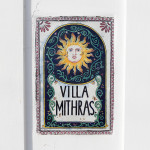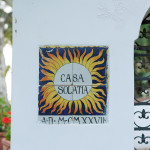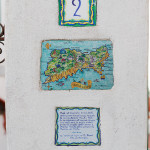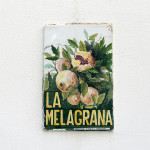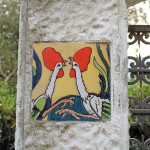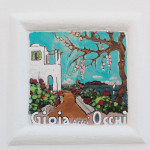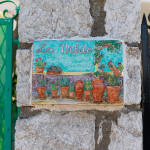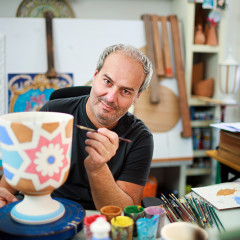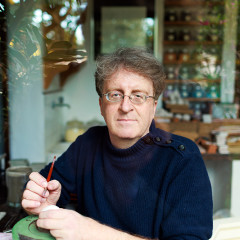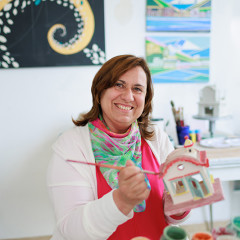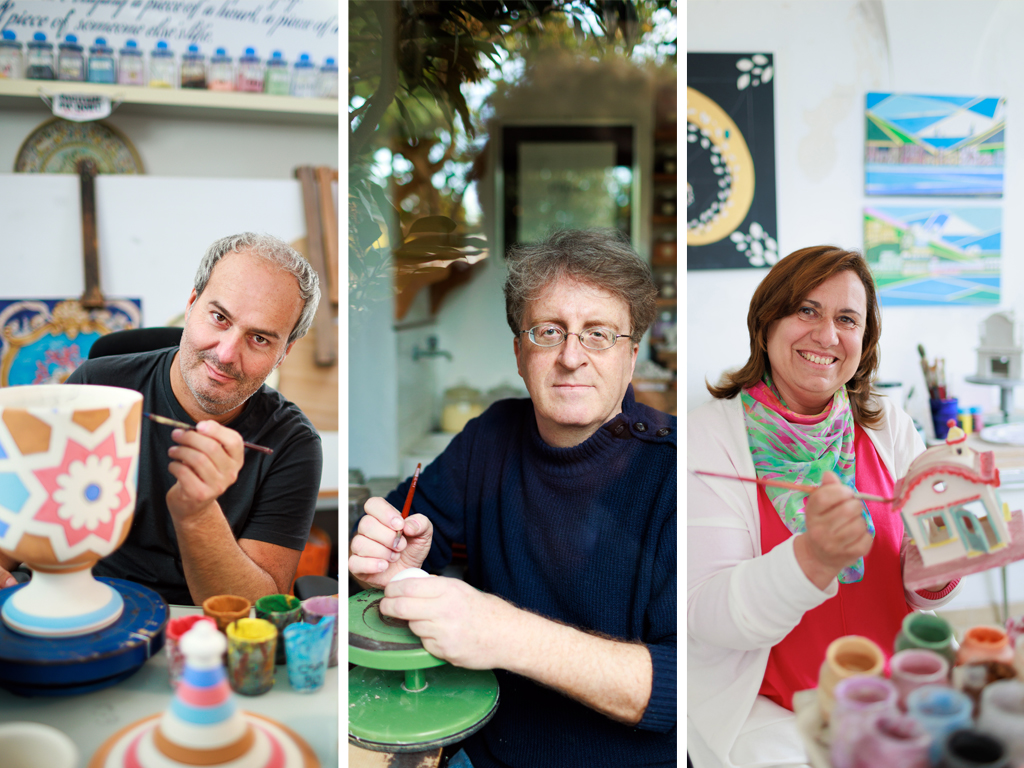
Ceramica mon amour
Modellare, cuocere, smaltare e decorare. Sono le azioni quotidiane di tre artigiani che, con passione, portano avanti un’antica arte isolana
di Marilena D’Ambro | foto di Davide Esposito
L’isola mostra la sua vera anima solo a chi riesce a sentirla. Riecheggia nei sussurri del vento, tinge di riflessi dorati le onde del mare, si nasconde nella terra profumata e aspetta un tocco gentile per risplendere. I ceramisti riescono a vedere questa trama lucente, ne diventano custodi e la trasformano in materia. Così, Capri rinasce ogni volta attraverso opere d’arte che tramandano antiche tradizioni. Ecco tre storie, tre forme dell’anima.
Ceramista per vocazione, Gennaro Tavassi è seduto al tornio nel laboratorio di Anacapri. Le mattonelle blu che si intravedono all’ingresso sono un invito a entrare come un’onda travolgente. Ha scelto Villa del Sole, una delle dimore più antiche di via Giuseppe Orlandi, per ospitare il suo universo di forme e colori. Lo sguardo è concentrato, il mondo fuori non lo sfiora. Le mani si muovono con leggiadria. Le sue creazioni lo abbracciano mentre decora.
Una linea di giallo scivola sul piatto ancora candido, il fruscio del pennello si interrompe quando comincia a raccontarsi: «Ho respirato arte fin da bambino: papà era architetto e mamma insegnava educazione artistica a scuola. Avevo vent’anni e mi ero da poco diplomato geometra, ancora non sapevo quale sarebbe stato il mio futuro ma l’incontro con il maestro ceramista Sergio Rubino ha dato una svolta alla mia vita». Rubino lo coinvolge nella realizzazione di Capri in Miniatura e in quel frangente scopre che le sue mani possono dare forma alle emozioni.
Il sodalizio artistico dura circa otto anni, un lungo percorso in cui Gennaro definisce la sua identità di artista e assorbe i segreti della ceramica: dalla lavorazione dell’argilla, alla cottura in forno fino al decoro. Mentre parla del suo mentore gli occhi brillano e ritornano indietro nel tempo, ricorda: «Sergio non parlava molto ma mostrava con grande generosità. Il suo insegnamento più importante? L’umiltà. Mi ha fatto capire che in questo mestiere un buon risultato è solo il punto di partenza per continuare a imparare e a migliorarsi».
Nel 2010 inizia la fase matura e apre la bottega artigiana a Villa del Sole. A supportarlo con incrollabile fiducia c’è la moglie Attilia, contatto con il pubblico e mente organizzativa del negozio. Qui l’artigiano mette a nudo la sua interiorità: esprime appieno la creatività e lo stile personale. «Villa del Sole ha inaugurato un cambio di passo da una ceramica classica a una ceramica più moderna. Senza però dimenticare la tradizione e il legame con il territorio».
Nutre il suo estro la bellezza dell’isola. Il posto del cuore? Le Boffe, centro storico di Anacapri. Ma non solo. Alimentano la fantasia i tessuti pregiati e i viaggi. «Se sono lontano trasferisco le idee su carta per tenerne traccia ma quando sono al laboratorio il richiamo della terra diventa irresistibile» dice. È proprio dalla terra mescolata all’argilla che prendono vita le sue ceramiche. Le mani creano, modellano guidate da ragione e sentimento. Poi, tocca alla cottura in forno. Il calore solidifica prima della fase decorativa in cui i colori danno personalità alle opere e si intrecciano ai fili dorati dell’anima.
«Questo è il passaggio più temuto e atteso per capire se l’oggetto concreto corrisponde alla mia immaginazione», racconta. «È sempre un po’ spiazzante stringere tra le mani qualcosa che esisteva solo nella mente.
È come un figlio desideroso di affacciarsi al mondo».
Tavassi accarezza con gli occhi le sue opere d’arte: «Per me fare ceramica significa suscitare un sentimento. Quando percepisco la gioia nel sorriso di chi mi ha scelto non ho bisogno di nulla, mi sento appagato.
So che un pezzo della mia anima illuminerà la vita di qualcun altro».
«Ho sempre pensato che la vera bellezza risplendesse nelle piccole cose» dice Sergio Di Pace aprendo le porte del suo laboratorio nel cuore di Anacapri, una casetta in legno che guarda verso Monte Solaro abbracciata da un giardino che profuma di limoni. Una volta superata la soglia, la realtà scompare per lasciare spazio alla fantasia.
L’effetto sorpresa è istantaneo: sono ceramiche in miniatura fatte e dipinte a mano, ninnoli colorati che racchiudono lo spirito dell’isola. Barchette a vela, maioliche, stelle marine, gattini paffutelli, lucertole azzurre, alberelli di limone, campanelle capresi, roselline di maggio. Tutte opere d’arte dai contorni dolci che compongono collezioni a tema.
Sembrano animate di vita propria. Si accoccolano nel palmo d’una mano, sussurrano che la felicità è semplice da trovare. Bisogna solo riconoscerla. Lo sguardo di Sergio è quello di un sognatore. Con la punta delle dita sfiora le sue creazioni e inizia a parlare di sé: «Ho cominciato nel 1997 quando ho registrato il marchio Oigré. Rappresenta la parte creativa della mia anima. L’altra è profondamente analitica e matematica, si è forgiata durante i miei studi alla facoltà di Economia. Per un periodo ho anche insegnato, poi ho deciso di seguire l’istinto».
D’altro canto, l’arte ha sempre fatto parte della sua vita: la madre Michelina era sarta e amava dipingere.
È stata lei ad accorgersi del talento di Sergio e a insegnargli come miscelare e ottenere i colori. Tutta la famiglia lo ha sempre sostenuto e incoraggiato, «il forno e il tornio sono un dono dei miei genitori». L’amore per la ceramica sboccia già da ragazzo. Segue un corso tenuto dai maestri Massimo Goderecci e Cecilia Sbandi e la semplice curiosità iniziale si trasforma in un fuoco sacro. Così, impara a impastare, modellare, cuocere, smaltare e ricercare i colori. Vive due anni di studio intenso e adorato. «Massimo era un ceramista con un’impostazione classica ma mi ha sempre lasciato libero di sviluppare il mio stile. Grazie a lui – ricorda – ho compreso che schemi e dogmi vanno anche superati».
Per ricercare il suo stile personale Sergio intraprende un lungo cammino di introspezione ma è stato lo scorrere della vita a suggerirgli la risposta. «La ceramica in miniatura non è arrivata subito. All’inizio tendevo a produrre forme in terracotta di grandi dimensioni composte da tanti piccoli pezzi di forma geometrica. Poi, ho capito che dovevo seguire la mia predisposizione: creare manufatti più piccoli e rivalutare il colore».
Tutta la sua produzione di ceramiche è ricavata dalla creta toscana e dal caolino, componente della porcellana. E prevede una doppia cottura: la prima per il supporto e la seconda per la smaltatura seguita dal decoro.
«La cottura in forno è tormento ed estasi, soprattutto se a cuocere è il numero uno di ogni collezione».
Le collezioni a cui è particolarmente affezionato? «La linea Vele. Barchette d’argilla che navigano verso la libertà e scandiscono gli anni di attività del laboratorio che quest’anno festeggia i venticinque anni».
Dalla montagna fiorita di Monte Solaro al borgo marinaro di Marina Grande. Qui sboccia Ceramicapri, laboratorio di ceramiche di Maria Pia Ferraiuolo. La piccola stanza è un prolungamento della sua casa.
Profuma di mare e terra: pennelli e colori sono ovunque. Creazioni in argilla aspettano di essere decorate per affacciarsi al mondo.
«La volontà di creare ha sempre fatto parte di me» racconta Maria Pia. «Mamma faceva la sarta, papà il muratore, ho vissuto in un ambiente ricco di stimoli. L’amore per la ceramica è maturato con il tempo.
La scintilla è scoccata quando mi resi conto che non riuscivo a stare lontana dal laboratorio di Sergio Rubino in piazza Boffe. Mi fermavo a lungo ad ammirare i suoi capolavori. Capii che desideravo imparare».
Per Maria Pia l’occasione si presenta a 16 anni quando frequenta un corso di ceramica tenuto da Massimo Goderecci presso le scuole medie di Capri. Qui apprende le basi: impara a modellare, cuocere, smaltare e decorare. Poi la vita, con le sue deviazioni, la costringe a mettere nel cassetto quel sogno. La famiglia e il lavoro diventano priorità ma la ceramica continua a tornare da lei.
Viene invitata a collaborare nella realizzazione di Capri in Miniatura insieme ad altri aspiranti ceramisti. «Anche se ero l’ultima arrivata, quell’esperienza riaccese il mio entusiasmo. Ebbi l’opportunità di osservare Rubino all’opera e compresi che c’era tanto da imparare. Le basi sono importanti ma l’esperienza va conquistata. Si impara dai successi ma soprattutto dagli errori. La ceramica è tempo e pazienza».
Nel 2006 comincia a dare forma al suo laboratorio. Il primo ad arrivare è il forno elettrico. Si trova nel giardino di casa, al sicuro e vicino all’anima. Poi, si è aggiunto il tornio.
Questa fase della vita professionale spinge Maria Pia ad affinare lo stile e la visione personale. Spiega che «la ceramica per me è sperimentazione. Anche se è influenzata dalla scuola napoletana tende ad andare oltre la tradizione classica. Le regole ci sono, servono, ma vanno infrante». Cosa la ispira? Le forme e i colori dell’isola, ma non solo, Molte sue creazioni hanno un fine sociale, si fanno portatrici di un messaggio. Vogliono indurre alla riflessione e al cambiamento e sottolinea che «le idee per le opere d’arte vengono in maniera naturale ma hanno bisogno di sedimentare. Non metto subito le mani in pasta, soprattutto per i pezzi più grandi o che sono ispirati da temi e avvenimenti che toccano la vita di ognuno di noi».
Tra le sue creazioni spiccano anche ceramiche tradizionali: piatti e maioliche che raffigurano decori e limoni, ricci e tentacoli da tavola. Oggetti d’arredo con forme particolari che sembrano nati dal mare. Ci sono le caprette colorate e stilizzate, simbolo di Ceramicapri. Realizzate in creta incarnano l’essenza dell’isola di Capri e si trasformano in un oggetto benaugurante.
Lo sguardo di Maria Pia si sposta verso il mare. Il blu fa capolino dalla finestra del laboratorio e culla pensieri. Conclude la ceramista: «Fare ceramica vuol dire aprire una porta tra realtà e fantasia. Ma c’è di più. Significa smuovere le coscienze e donare felicità. Quando capisco di esserci riuscita non c’è soddisfazione più grande».
Gennaro Tavassi
Nelle sue creazioni l’effetto plastico è immediato. I colori scelti sono quelli di Capri: il blu del mare, il giallo del sole, il verde di Cetrella, il rosso dei coralli. Le cromie vivificano con grazia lo sfondo bianco di piatti, bicchieri, vasi e piastrelle ed esaltano i simboli della terra natia: limo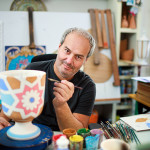 ni, grappoli d’uva, polpi e pesci. C’è spazio anche per l’astrattismo, le geometrie e gli accostamenti cromatici audaci.| Gennaro Tavassi. The plasticity of his creations is immediately apparent. The colours he chooses are those of Capri: the blue of the sea, the yellow of the sun, the green of Cetrella, the red of the coral. The colours bring a delightful touch of life to the white background of plates, tumblers, vases and tiles, and enhance the symbols of his native soil: lemons, grapes, octopuses and fish. There’s also room for abstract designs, geometric patterns and bold combinations of colour.
ni, grappoli d’uva, polpi e pesci. C’è spazio anche per l’astrattismo, le geometrie e gli accostamenti cromatici audaci.| Gennaro Tavassi. The plasticity of his creations is immediately apparent. The colours he chooses are those of Capri: the blue of the sea, the yellow of the sun, the green of Cetrella, the red of the coral. The colours bring a delightful touch of life to the white background of plates, tumblers, vases and tiles, and enhance the symbols of his native soil: lemons, grapes, octopuses and fish. There’s also room for abstract designs, geometric patterns and bold combinations of colour.
Sergio Di Pace
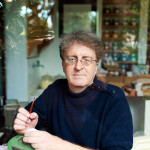 Le sue creazioni comunicano grazia ed eleganza. Non si limitano all’esperienza visiva ma rievocano emozioni tattili come, ad esempio, le piccole ceramiche che raffigurano delle piante grasse dove la superficie viene scavata con uno spillo per suscitare una sensazione pungente.| Sergio Di Pace. His creations communicate grace and elegance. They are not limited to the visual effect but also evoke tactile impressions, as with the small ceramic cactuses where the surface is scraped with a pin to produce a prickly sensation.
Le sue creazioni comunicano grazia ed eleganza. Non si limitano all’esperienza visiva ma rievocano emozioni tattili come, ad esempio, le piccole ceramiche che raffigurano delle piante grasse dove la superficie viene scavata con uno spillo per suscitare una sensazione pungente.| Sergio Di Pace. His creations communicate grace and elegance. They are not limited to the visual effect but also evoke tactile impressions, as with the small ceramic cactuses where the surface is scraped with a pin to produce a prickly sensation.
Maria Pia Ferraiuolo
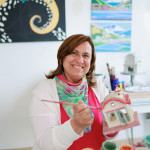 Le sue creazioni sono oggetti di uso comune che si trasformano in opere d’arte. Pezzi unici creati e dipinti a mano con un’identità che non può essere replicata. Spesso sono caratterizzate da elementi astratti e forme originali che lasciano spazio all’interpretazione. Si vestono di cromie accese, soprattutto azzurre, rosse e verdi.| Maria Pia Ferraiuolo. Her creations are common everyday objects that transform into works of art. Unique pieces, created and painted by hand, with an identity that cannot be replicated. Often they feature abstract elements and unusual shapes that leave scope for interpretation. They are decorated in bright colours, mainly blue, reds and greens..
Le sue creazioni sono oggetti di uso comune che si trasformano in opere d’arte. Pezzi unici creati e dipinti a mano con un’identità che non può essere replicata. Spesso sono caratterizzate da elementi astratti e forme originali che lasciano spazio all’interpretazione. Si vestono di cromie accese, soprattutto azzurre, rosse e verdi.| Maria Pia Ferraiuolo. Her creations are common everyday objects that transform into works of art. Unique pieces, created and painted by hand, with an identity that cannot be replicated. Often they feature abstract elements and unusual shapes that leave scope for interpretation. They are decorated in bright colours, mainly blue, reds and greens..
Le mattonelle raccontano
Raccontano storie, tradizioni, aneddoti e segreti. Offrono indicazioni e consigli, vestono con eleganza panchine e pavimenti. Ma c’è di più. Le maioliche a Capri definiscono l’identità di ville, case e proprietari. Strade e vicoletti custodiscono piccole opere d’arte e una semplice passeggiata diventa una scoperta.
L’abitudine di abbellire le dimore con mattonelle sembra risalga alla fine del Settecento quando le famiglie benestanti dell’isola decoravano gli ingressi per comunicare il proprio status. Poi, con il tempo, è diventata una consuetudine comune. Alcune sono maioliche d’autore come quella che identifica Villa Mithras, in via Caprile ad Anacapri, porta la firma di Torquato Castellani, uno dei massimi esponenti della ceramica italiana e ci dice qualcosa sull’antica proprietaria della villa: Edith Hemsted.
La donna inglese fece costruire l’abitazione nel 1894 e la chiamò, appunto, Villa Mithras in onore del dio persiano del sole, Mitra. Pare, infatti, che Lady Hemsted praticasse rituali legati all’adorazione di tale divinità il cui culto era diffuso sull’isola già all’epoca di Tiberio.
Sempre ad Anacapri c’è un’altra maiolica che ha qualcosa da raccontare, si trova alle Boffe, centro storico del paese. Fu realizzata dal ceramista Domenico Gentile all’esterno della sua abitazione e bottega. Il pannello mostra una donna che sale la Scala Fenicia con un vaso carico d’acqua e in equilibrio sulla testa. L’opera si ispira al dipinto di Teodoro Duclère Donna di Capri. Altre opere di Gentile caratterizzano gli ingressi di alcune villette in via Vignola. Si susseguono uno dopo l’altro: I Gemelli, Li Campi e Cri Cri Cri Cri.
Nell’antico quartiere di Catena fanno capolino quadretti in ceramica che raccontano il sacro e il profano. Tra queste quella che raffigura i magi mentre offrono i doni al neonato Gesù. Dà il nome all’omonima villa e ne arricchisce l’entrata. Questa piastrella sussurra che il proprietario è un attento conoscitore della religione cristiana. Come mai? Sa che i magi non erano re come si è soliti credere. La stessa immagine è riprodotta su un’altra targa collocata tra l’ingresso di via Catena e viale Tommaso De Tommaso: la firma è dell’artista Ilio Palumbo, che sia l’autore di entrambe le opere?
Quelle firmate Massimo (Goderecci) costellano Capri in lungo e in largo. La sua arte ravviva anche i luoghi più lontani dal centro, quelli dove l’anima vibra. Otre via Dentecala, attira lo sguardo La noce della piazzetta. La piastrella adorna l’ingresso di un’abitazione e anticipa il belvedere di Piazzetta delle Noci. La sensazione? Magia.
A via Tragara incontriamo di nuovo una piastrella del ceramista Ilio Palumbo. L’opera impreziosisce l’esterno della casa che fu di Pietro Capuano, noto gioielliere conosciuto come Chantecler. La maiolica ritrae due galli, l’uno di fronte all’altro, che annunciano l’alba. E delineano le abitudini del proprietario che amava festeggiare fino alle prime luci.
Le maioliche delle case di Capri sono migliaia di piccoli mondi in cui entrare per conoscere e sognare.| Stories told by the tiles. Tey tell stories and recount traditions, anecdotes and secrets. They offer suggestions and advice, and elegantly adorn benches and floors. But there’s more. The majolica tiles on Capri define the identity of villas, homes and their owners. Streets and alleys house little works of art, and a simple stroll turns into a journey of discovery.
The habit of decorating homes with tiles seems to date back to the late 18th century when the well-off families of the island started decorating their entrances as a sign of their status. Over time it became a common custom. Some are artist-designed majolica tiles, such as the one on Villa Mithras in Via Caprile in Anacapri: it was created by Torquato Castellani, one of the greatest Italian ceramics artists, and tells us something about the former owner of the villa, Edith Hemsted. This English woman had the house built for her in 1894 and she called it Villa Mithras after the Persian god of the sun. Indeed, it appears that Lady Hemsted used to practise rituals linked to the worship of this god, whose cult was widespread on Capri back in the time of Tiberius’s reign.
Another majolica tile with a story to tell, also in Anacapri, is in Le Boffe, in the historic town centre. The tile was made by ceramics artist Domenico Gentile and placed outside his house and workshop. The panel shows a woman walking up the Scala Fenicia with a jar full of water balanced on her head. The work is inspired by a painting by Teodoro Duclère, Donna di Capri (Capri Woman). Other works by Gentile feature on the gateways to some of the villas in Via Vignola, following one after another: I Gemelli, Li Campi and Cri Cri Cri Cri.
In the old quarter of Catena, some square ceramic tiles can be seen showing both sacred and profane scenes. These include a tile featuring the Magi offering their gifts to the infant Jesus. It gives its name to the villa (Villa I Magi) and embellishes the entrance. The tile hints that the owner is well-schooled in the Christian faith. How? Because he knows that the Magi were not kings, as was the customary belief. The same image is reproduced on another plaque in between the entrance to Via Catena and Viale Tommaso De Tommaso. That tile is the work of the artist Ilio Palumbo, so perhaps he was the artist behind both works?
The tiles designed by Massimo (Goderecci) appear all over Capri. His art brings life to some of the places furthest away from the centre, where the soul resonates. Beyond Via Dentecala, our gaze is drawn to La Noce della Piazzetta. The tile adorns the entrance to a house, anticipating the belvedere in the Piazzetta delle Noci. It evokes a feeling of magic.
In Via Tragara we find another tile by the ceramic artist Ilio Palumbo. The work adorns the outside of the house that belonged to Pietro Capuano, a well-known jeweller known as Chantecler. The majolica tile shows two cockerels, one in front of the other, announcing the dawn. And they show the habits of the owner, who liked to party until the first light of dawn.
So as you stroll around Capri you will come across thousands of little worlds that you can enter: worlds to get to know and dream about.
Ceramics mon amour
Shaping, firing, glazing and decorating: the everyday activities of three artisans, all keen practitioners of an ancient island craft
by Marilena D’Ambro | photos by Davide Esposito
The island only shows its true soul to those who can feel it. It re-echoes in the whispers of the wind, paints the waves of the sea with gold reflections, hides in the fragrant earth waiting for a gentle touch to make it shine. The ceramicists can see this gleaming weave: they become its guardians and transform it into material. Thus, Capri is reborn each time through works of art that pass on ancient traditions. Here are three stories and three forms of that island soul.
Gennaro Tavassi, who found his vocation as a ceramic artist, is sitting at his lathe in his workshop in Anacapri. The blue ceramic tiles that you can see through the doorway draw people in as though swept along on a wave. He chose Villa del Sole, one of the oldest houses in Via Giuseppe Orlandi, as the home for his world of shapes and colours. His gaze is concentrated, and the world outside doesn’t impinge on him. His hands move gracefully as he decorates, surrounded by his creations. A yellow line slides across the white plate; the swish of his brush stops as he begins to tell us about himself: “I’ve lived and breathed art since I was a child: my dad was an architect and my mum taught art education at school. At 20 years old, having just qualified as a surveyor, I didn’t yet know what my future would be, but then I met the master ceramic artist Sergio Rubino and that changed my life.” Rubino involved him in making ‘Capri in Miniature’ and that was the critical juncture when he discovered how his hands could give shape to emotions. Their artistic partnership lasted about eight years, a long period in which Gennaro came to define his identity as an artist and absorbed the secrets of ceramics: from working the clay to firing in the kiln and finally the decoration. His eyes shine as he speaks about his mentor, going back in time through his memories: “Sergio didn’t talk a lot, but he was very generous in demonstrating his art. His most important lesson? Humility. He made me realize that getting a good result in this craft is only the starting point on a continual path of learning and improvement.” In 2010 his mature phase began as he opened his craft shop in Villa del Sole. He is supported by the unshakeable belief of his wife Attilia, who manages contact with the public and the administrative matters of the shop. It is here that the craftsman lays bare his inner life, expressing his creativity and personal style to the full. “Villa del Sole has marked a change of pace from classical pottery to a more modern ceramics, but without forgetting tradition and my bond with the territory.” The beauty of the island feeds his creativity. His favourite place? Le Boffe, the historic town centre of Anacapri. But not only that. His imagination is also inspired by fine fabrics and by his travels. “When I’m away, I transfer my ideas onto paper to keep track of them, but when I’m in my workshop the call of the earth becomes irresistible,” he says. And it is from the earth, mixed with clay, that his ceramics take shape. His hands create and shape, guided by reason and feeling. Then it’s time for the firing. The heat hardens the clay before the decorative phase, when the colours give personality to the works and intertwine with the golden threads of the soul. “This is the most dreaded, but also the most keenly anticipated phase, when I discover if the concrete object corresponds to my imagination,” he explains. “It’s always a bit disorientating to hold something in your hands that previously existed only in the mind. It’s like a child wanting to go out onto the world.” Tavassi caresses his works of art with his eyes: “For me, working in ceramics means arousing emotion. When I see the joyful smile of someone who has chosen me to make something, I don’t need anything more: I feel fulfilled. I know that a piece of my soul will light up someone else’s life.”
“I’ve always thought that true beauty shines in the small things,” says Sergio Di Pace, opening the doors of his workshop in the heart of Anacapri, a wooden cottage that looks out onto Monte Solaro, surrounded by a garden filled with the scent of lemon trees. When you cross the threshold, reality disappears, to make room for the imagination. The surprise effect is instantaneous. Before you is a host of miniature ceramics, all handmade and hand-painted: colourful knick-knacks that encapsulate the spirit of the island. There are little sailing boats, majolica tiles, starfish, plump kittens, blue lizards, lemon trees, Capri bells, and May roses. All beautifully shaped works of art making up themed collections. They seem to have a life of their own. They nestle into the palm of a hand, whispering that happiness is easy to find: you just need to recognize it. Sergio has the gaze of a dreamer. He brushes his creations with his fingertips as he starts to tell us about himself: “I started in 1997 when I registered the Oigré trademark. It represents the creative side of my soul. The other side is intensely analytical and mathematical: it was forged during my university studies in Economics. I taught for a while, and then I decided to follow my instincts.” On the other hand, art has always been part of his life: his mother Michelina was a dressmaker and loved painting. She was the one who recognised Sergio’s talent and who taught him how to mix and obtain colours. The whole family has always supported and encouraged him: “The kiln and lathe were gifts from my parents.” His love of pottery started while he was still a boy. He attended a course with master ceramic artists Massimo Goderecci and Cecilia Sbandi, and what started as simple curiosity became a real passion. Thus he learned to work the clay, to model, fire, glaze and explore colours. He underwent two years of intense study, which he loved. “Massimo was a ceramicist with a classical approach but he always left me free to develop my own style. Thanks to him I understood that norms and dogmas also need to be superseded.” In searching for his own personal style, Sergio embarked on a long path of introspection, but it was the continuing flow of life that suggested the answer to him. “The idea of miniature ceramics didn’t come immediately. At first I tended to produce large terracotta shapes made up of lots of small geometrical pieces. Then I realised that I had to follow my inclination: to create smaller objects and reassess the colours.” All his ceramic products are made from Tuscan clay and kaolin, a component of porcelain. And they require double firing: the first firing for the body and the second for the glaze, followed by the decoration. “Kiln firing is a torture and ecstasy, especially when you’re firing the first piece in a collection.” Which collections is he particularly fond of? “The Vele line. They’re clay boats that are sailing towards freedom and they mark each year of activity of the workshop, which is now celebrating its 25th anniversary.”
From the flowery mountainside of Monte Solaro to the harbour town of Marina Grande. This is the site of Ceramicapri, the ceramics workshop belonging to Maria Pia Ferraiuolo. The small room is an extension of her house. It smells of the sea and earth: paintbrushes and colours are everywhere. Clay creations await decoration before they go out into the world. “The desire to create has always been a part of me,” says Maria Pia. “Mum was a dressmaker and Dad a builder, so I lived in an environment with plenty of stimulation. My love of ceramics developed over time. The spark came when I realised that I couldn’t keep away from Sergio Rubino’s workshop in Piazza Boffe. I would linger there for ages admiring his wonderful pieces. I realized that I wanted to learn the craft.” For Maria Pia the opportunity arrived when she was 16 and attended a ceramics course run by Massimo Goderecci at the middle schools on Capri. Here she learned the basics: she learned to model, fire, glaze and decorate. Then the twists and turns of life forced her to shut the dream away in a drawer. Family and work became her priority, but ceramics kept coming back into her life. She was invited to collaborate in making Capri in Miniature together with other aspiring ceramicists. “Although I was the last to arrive, that experience rekindled my enthusiasm. I had the chance to watch Rubino at work and I understood that there was a lot to learn. The basics are important but you have to gain experience. You learn from successes, but above all from mistakes. Ceramics consists of time and patience.” In 2006 she began setting up her workshop. The first item to arrive was the electric kiln. It’s in the garden of her house, a safe place close to the heart of the house. Then came the lathe. This phase in her professional life pushed Maria Pia to refine her style and her personal vision. As she explains: “For me, ceramics is experimentation. Although it’s influenced by the Neapolitan school, it tends to go beyond classical tradition. There are rules and they’re useful, but they also need to be broken.” What inspires her? The shapes and colours of the island, but not only that. Many of her creations have a social purpose, and carry a message. They lead people to reflect and change; she stresses that: “Ideas for works of art come naturally, but they need to settle. I don’t put my hands into the clay straightaway, especially with the bigger pieces, or the ones inspired by topics and events that touch all our lives.” Her creations also include traditional ceramics: plates and majolica tiles depicting decorative motifs and lemons, tableware with sea urchins and tentacles. Items of furniture with unusual shapes that seem to have come from the sea. Then there are the colourful stylized goats, the symbol of Ceramicapri. Made from clay, they embody the essence of the island of Capri and turn into a good luck object.
Maria Pia raises her gaze to the sea. The blue can be glimpsed from the window of the workshop and nurses her thoughts. “Being a ceramic artist means opening a door between reality and imagination,” she says. “But more than that, it means jogging people’s consciences and bringing happiness. When I realise that I have succeeded in doing that, there is no bigger satisfaction.”


